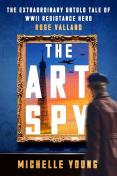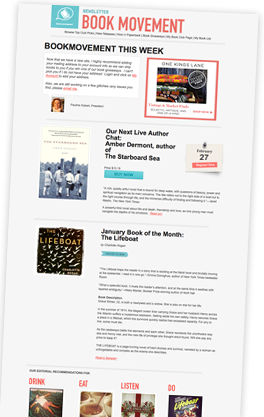BKMT READING GUIDES
The Art Spy: The Extraordinary Untold Tale of WWII Resistance Hero Rose Valland
by Michelle Young
Hardcover : 400 pages
0 club reading this now
0 members have read this book
On August 25, 1944, Rose Valland, a woman of quiet daring, found herself in a desperate ...
Introduction
A riveting and stylish saga set in Paris during World War II, The Art Spy uncovers how an unlikely heroine infiltrated the Nazi leadership to save the world's most treasured masterpieces.
On August 25, 1944, Rose Valland, a woman of quiet daring, found herself in a desperate position. From the windows of her beloved Jeu de Paume museum, where she had worked and ultimately spied, she could see the battle to liberate Paris thundering around her. The Jeu de Paume, co-opted by Nazi leadership, was now the Germans’ final line of defense. Would the museum curator be killed before she could tell the truth—a story that would mean nothing less than saving humanity’s cultural inheritance?
Based on troves of previously undiscovered documents, The Art Spy chronicles the brave actions of the key Resistance spy in the heart of the Nazi’s art looting headquarters in the French capital. A veritable female Monuments Man, Valland has, until now, been written out of the annals, despite bearing witness to history’s largest art theft. While Hitler was amassing stolen art for his future Führermuseum, Valland, his undercover adversary, secretly worked to stop him.
At every stage of World War II, Valland was front and center. She came face to face with Reichsmarschall Hermann Göring, passed crucial information to the Resistance network, put herself deliberately in harm’s way to protect the museum and her staff, and faced death during the last hours of Liberation Day.
At the same time, a young Free French soldier, Alexandre Rosenberg , was fighting his way to Paris with the Allied forces battling to liberate France. Alexandre's father was the exclusive art dealer for Picasso, Matisse, George Braque, and Fernand Léger. The Nazis had taken everything from their family—their art collection, their nationality, their gallery, and their home in Paris.
Vivid and atmospheric, The Art Spy moves from the glittering days of pre-War Paris, home to geniuses of modern culture, including Picasso, Josephine Baker, Coco Chanel, Le Corbusier, and Frida Kahlo, through the tension-riddled cities and resorts of Europe on the eve of war, to the harrowing years of the Nazi occupation of France when brave people such as Valland and Rosenberg risked everything to fight monstrous evil.
In the spirit of Hidden Figures, with the sweeping narrative of The Rape of Europa and the depth of The Resistance Quartet, The Art Spy is an extraordinary tale of a female hero whose courage and tenacity in a time of violence and terror is an inspiration for us all.
Editorial Review
No Editorial Review Currently AvailableExcerpt
PARISAugust 19–20, 1944
A torrential storm was pummeling Paris, turning the skies forebodingly dark over a city in the midst of a tense mandatory blackout. The clamor of thunder and the sounds of war rose to a crescendo as the battle for Paris began. ...
Discussion Questions
1. What motivates Verne’s grudge against Rose? What past events or personal biases might have fueled his negative feelings toward her?2. Rose navigates and even assimilates with the elite social circles of France, but never fully fits in. Can you identify specific moments in her journey where this duality influenced her career? Did it help or hinder her professional development in Paris?
3.The exhibition in Munich was a direct response to the political climate of Nazi Germany. What do you think the exhibition was trying to achieve, and what does the overwhelming visitor turnout suggest about the public’s attitude toward the art displayed? Do you believe the exhibition was effective in fulfilling its mission? Why or why not?
4. The significance of Rose’s acquisition of Frida Kahlo’s portrait raises questions about their personal lives. After learning more about Kahlo’s life, what similarities can you draw between her and Rose? Why might Rose have been particularly drawn to this portrait?
5. On page 69, Rose describes the protection of French art as “one of the first reflexes of defense of our country.” What do you think she means by this statement, and how does it reflect the broader significance of art in times of war?
6. The role and importance of art during World War II is often overlooked in mainstream narratives about the war. How does exploring the events of WWII through the lens of art history enhance your understanding of the war’s broader cultural impacts, and its impact on both the individual and society? How does this perspective shift our view of
the conflict’s human cost and legacy?
7. Rose forms meaningful connections with women like Madeleine Bernheim throughout her career and involvement in the war resistance movement. How do these connections differ from her interactions with her male colleagues? What does this say about gender dynamics in the art world during this time?
8. Rose frequently risked her life to protect the Jeu de Paume and its collections. Given her lack of official recognition and compensation, what drives her to make these sacrifices? What do you think motivates her commitment to preserving art despite the personal cost?
9. Rose chooses to remain somewhat passive during the rise of resistance groups in art museums. What do you think influenced her decision to “keep her head down” (pg 134)? In your opinion, would she have been accepted if she had aligned herself with these groups?
10. Picasso and others show extraordinary acts of solidarity and protection during the war, such as when Picasso protects Matisse’s vault by fooling the German soldiers who came to search it. What are some key moments in the book where characters demonstrate defiance or selflessness in the face of danger? How do these actions compare to larger acts of resistance?
11. Rose and Joyce’s relationship, marked by secrecy and their shared closeted identity, adds complexity to their experiences during the Nazi occupation. How do the societal pressures on women, particularly in the context of their relationship, impact their lives before and during the war? How does this secrecy influence their choices and interactions, especially in a time when personal identities had to be carefully guarded?
12. Rose, a diligent documenter, never writes a single word about Joyce’s arrest—a striking omission given their closeness. How might the secrecy surrounding their romantic relationship influence Rose’s decision to leave this out of her private and personal records? What does this omission reveal about the personal struggles they faced?
13. Betrayal by close friends is a recurring theme in wartime, as seen through various examples in the book. Why do you think such acts of treason occurred during a time when people needed as much support and allyship as they could get?
14. Women often risked their lives for the war effort but received little recognition. Can you think of moments in the story where women were sidelined by their male counterparts despite their bravery? How might this impact their morale?
The liberation of Paris becomes tense for Rose when the crowd outside the Jeu de Paume turns against her. What might have motivated this sudden shift in the crowd’s celebratory sentiment, and what does this moment reveal about public perception in times of political upheaval?
15. In the Epilogue, we learn about Rose and Rorimer’s relationship post-liberation. Given Rose’s tendency to distrust others, especially men, what do you think allowed her to place so much trust in Rorimer?
16. Rose claims she did it all “to save a little beauty of the world” (pg 299). Do you think the aesthetic preservation of art was Rose’s primary motivation, or was there something deeper that drove her actions?
Book Club Recommendations
Recommended to book clubs by 0 of 0 members.
Book Club HQ to over 90,000+ book clubs and ready to welcome yours.
Get free weekly updates on top club picks, book giveaways, author events and more








